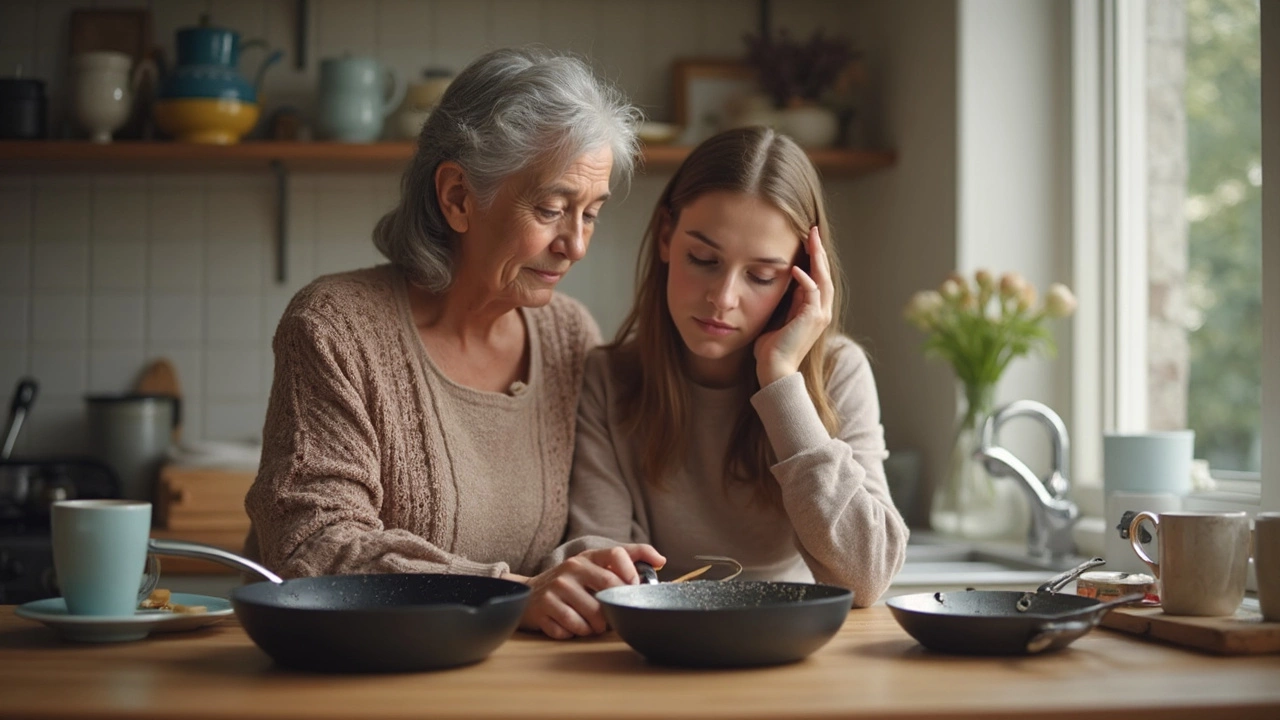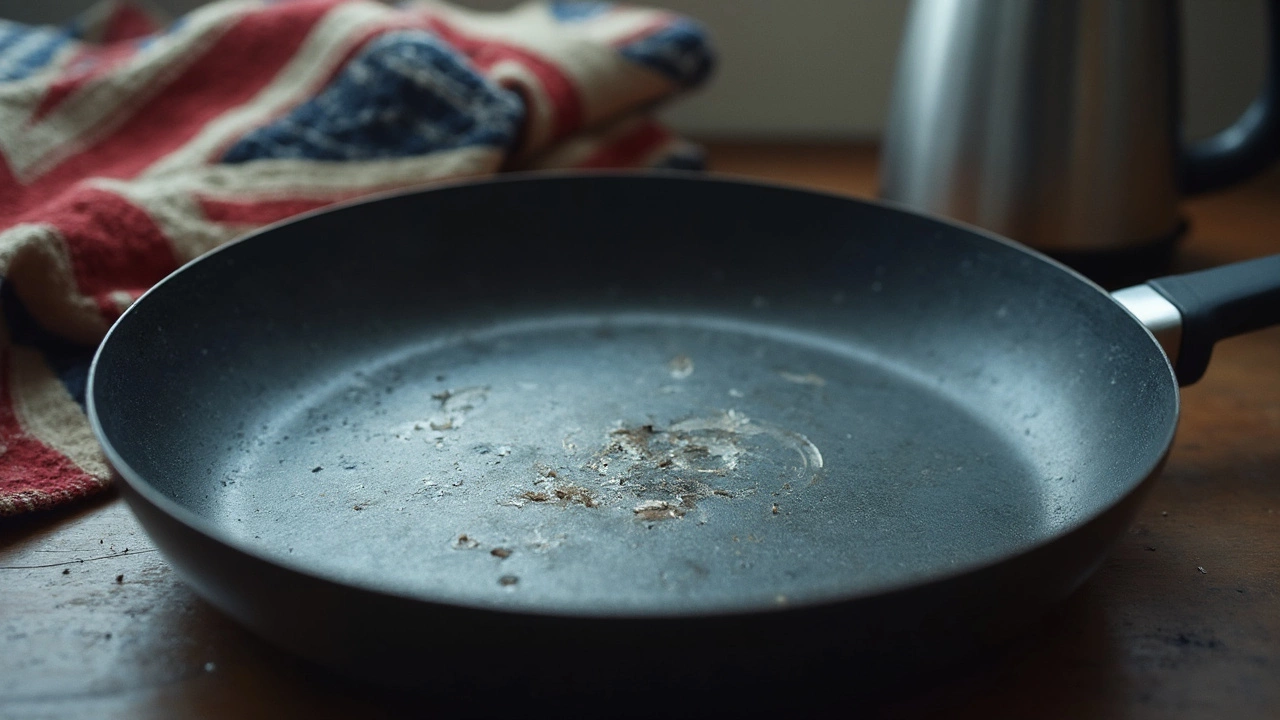Should You Throw Away Teflon Pans? The Real Risks and Smarter Kitchen Choices
 May, 13 2025
May, 13 2025
Ever looked at your scratched-up nonstick pan and wondered if it’s actually safe? If it’s Teflon, you’re not alone—loads of people have this exact worry. There’s a ton of debate about whether these pans belong in the trash or if it’s just one big internet scare.
The truth is, most Teflon pans are coated with something called PTFE. This coating stops eggs and pancakes from sticking like glue to the pan, which is awesome on busy mornings. But once that nonstick layer starts to flake or gets overheated, things get a little controversial.
For anyone with kids (like Dorian and Selena, my very own breakfast critics), safety in the kitchen matters a lot—nobody wants to risk a toxic meal over a crusty old skillet. So before you chuck your pans or replace your whole set, let’s break down what’s really important so you can keep your kitchen smart and your cooking safe.
- What Actually Is Teflon?
- Health Risks: Are Teflon Pans Dangerous?
- When Should You Toss a Teflon Pan?
- Alternatives and Care Tips
What Actually Is Teflon?
Teflon is a brand name for a super slippery material called polytetrafluoroethylene, or PTFE. Scientists came up with PTFE back in the 1930s, and it totally changed cooking. PTFE works because it won’t react with most foods or liquids, and it handles fat, oil, and even sticky stuff with almost zero effort. You’ll see the name Teflon used a lot, but it’s just one company’s take on this nonstick coating—plenty of other brands use PTFE too.
The main goal of Teflon pans is to make life easier: no scrubbing burned eggs, no soaking the pan overnight, and less oil needed for cooking. This is why nonstick pans became an instant hit in home kitchens. The coating is applied as a thin layer over metal, usually aluminum. The trick is, this layer is super sensitive to scratching or overheating.
Fun fact: PTFE is used outside kitchens, too—it shows up in waterproof jackets, plumbing tape, and even spacecraft! But its most famous role is definitely in frying pans and saucepans. If you’ve ever had pancakes slide off your spatula without a fight, that’s Teflon doing its job.
There is something that confuses lots of people, though: Teflon doesn’t have the same safety concerns as PFOA, a chemical once used in making PTFE but phased out in cookware by 2013. So if your nonstick pan was made in the last decade, it won’t have PFOA, but it still has that nonstick PTFE layer that needs some basic care.
Health Risks: Are Teflon Pans Dangerous?
It’s easy to get worried about what’s really happening when you use a Teflon pan, especially since the word “nonstick” sounds so high-tech. Here’s what’s actually going on. The magic layer on most nonstick cookware is called PTFE (Polytetrafluoroethylene). While PTFE itself is stable and safe at normal cooking temperatures, things get dicey if you turn up the heat too high.
Teflon starts to break down and release fumes when you heat it above 500°F (260°C). Unless you accidentally leave your pan empty on a burner for a while, regular stovetop cooking usually won’t touch those temperatures. But, if it does get that hot, the fumes aren’t great for your lungs—pet birds are especially sensitive, and there’ve been cases where birds died because of overheated Teflon.
Another concern? Old Teflon used to be made with something called PFOA, a chemical that’s been tied to health issues like cancer and hormone problems. But here’s the good news: Since 2013, PFOA is basically gone from new Teflon pans sold in North America and Europe. If your nonstick pans are older than middle school, though, it might be time to think about an upgrade.
Let’s lay out the facts so it’s simple:
| Risk | When It Happens | How Serious? |
|---|---|---|
| Fume Release | Overheating pan above 500°F/260°C | Can cause flu-like symptoms ("Teflon flu") in people and is deadly for pet birds |
| Flaking or Scratched Coating | Pans with chips or peeling nonstick layer | Small flakes are considered non-toxic but not appetizing |
| PFOA Exposure | Old pans made before 2013 | Linked to health risks; modern pans are PFOA-free |
Here’s the bottom line: The Teflon pans you see on shelves now are much safer than they used to be. The real risk is from badly scratched pans, overheating, or using models made before 2013. If you’re cooking for your family (or yourself), just watch the heat and check your cookware labels. If you’ve got birds at home, maybe keep them out of the kitchen completely when using nonstick stuff, just to be extra safe.

When Should You Toss a Teflon Pan?
Here’s the deal: not every old Teflon pan needs to go straight in the trash, but certain signs mean it’s time to let go. The big red flag? Scratches or flaking. Once the coating starts to chip or peel, you’re cooking on borrowed time (and you don’t want those flakes ending up in your eggs).
Pretty much every manufacturer, from cheap brands to big names, says if the surface of your nonstick pan looks damaged, it’s done. The American Cancer Society makes it clear:
"Throw away nonstick pans if the coating starts to peel to avoid ingesting flakes or causing fumes from overheating."It’s that simple.
- Teflon pans that are over five years old—even with gentle use—can lose their nonstick power, making cooking rough and cleanup even worse.
- If the pan is warped or you see deep scratches (think metal utensil accident), it’s time to upgrade. Hot spots and uneven surfaces can ruin recipes and safety.
- Another warning sign? That dreaded sticky feeling. If food clings even after a good wash, your pan’s nonstick life is pretty much over.
If you do spot flaking or peeling, don’t try to scrape it off and keep going. Flakes of the PTFE coating aren’t tasty, and while small amounts may not make you sick, experts agree it’s not worth the risk—especially for kids and anyone with health worries. Plus, damaged pans can release fumes at lower temperatures, especially if you crank the heat too high.
Quick tip: always follow the care guide—hand wash, avoid metal tools, and never blast the heat above medium-high. If you’ve already messed up the coating, it’s probably cheaper (and safer) to just buy a new one.
Alternatives and Care Tips
If you’re tired of worrying about your old Teflon pans, there are some solid alternatives out there—each with their own pros and cons.
- Stainless Steel: Super durable and can handle high heat, but you'll need more oil to keep food from sticking. Great for searing and browning.
- Cast Iron: Lasts forever if you take care of it, and gets better with time as it builds up its own nonstick "seasoning." Needs a little weekend maintenance, but it’s practically indestructible.
- Ceramic-Coated: These pans have a smooth surface that doesn’t contain PTFE or PFOA. They’re not quite as long-lasting as the old-school stuff, but they make a safer pick if you’re worried about chemicals.
- Carbon Steel: Think of it as cast iron’s skinnier cousin—lighter, heats up faster, and also builds seasoning with use.
No matter what you use, pan care makes a huge difference. Want to make your nonstick pans—even Teflon—last longer? Try these simple tips:
- Always use silicone, wood, or plastic utensils to avoid scratching the coating.
- Keep your burners on low to medium—overheating is what releases fumes and ruins the coating fastest. Teflon pans start breaking down around 500°F (260°C).
- Hand wash only. Skip the dishwasher, which can chip away at nonstick layers and make pans wear out faster. Hot soapy water with a soft sponge is all you need.
- If your pan is flaking, warping, or looks scratched up, it’s time to say goodbye—don’t risk bits of coating getting into your dinner.
Here’s a quick side-by-side of how different types of cookware stand up against each other:
| Material | Nonstick | Heat Tolerance | Average Lifespan | Key Care Tip |
|---|---|---|---|---|
| Teflon | Yes (until scratched) | Up to 500°F (260°C) | 2-5 years | Never use metal tools |
| Stainless Steel | No | Very High | 10+ years | Preheat with oil for best results |
| Cast Iron | If seasoned | Very High | Lifetime | Dry thoroughly; oil after washing |
| Ceramic-Coated | Yes | Low to Medium | 6 months-2 years | Gentle cleaning, avoid high heat |
| Carbon Steel | If seasoned | Very High | Lifetime | Season like cast iron |
If you want to go nonstick for life with less hassle, keep one good ceramic pan around for eggs and pancakes, and use stainless or cast iron for everything else. That’s one less thing to worry about when you’re cooking for a hungry family.